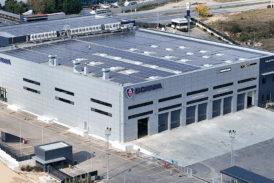New Mirror Reflex
Digital cameras are making our lives easier in many different situations: They allow us to make video calls, for example. And they can be used with robots to inspect even the smallest passageways or channels. In medicine, they are used to provide important information about the human body. And they have also proven useful in the field of transportation – as rear-view cameras in cars, for example. Mercedes-Benz Trucks is going a step further with the MirrorCam of the Actros and Arocs. It does more than just replace the conventional rear-view mirror.

If you’ve ever been on the road with a trailer, you know how difficult it is to back up in a curve and try to avoid it whenever possible. As soon as you turn the steering wheel and the trailer starts to angle back, you suddenly see too much trailer and too little road in the rear-view mirror on the inner side of the curve. Manoeuvring a semi-trailer over 18 meters long is even more difficult. Despite the rear-view and wide-view mirrors, the mirror on the inside of the curve often shows only the side of the trailer because of the angle formed by the tractor and trailer. The help it provides in these situations is one of the many benefits of the new MirrorCam, which has been installed as standard equipment on the new Actros and Arocs models of Mercedes-Benz Trucks since June 2019.
 Digitization for more visibility
Digitization for more visibility
Instead of the massive external mirrors typically used in the past, Mercedes-Benz trucks are now equipped with small, streamlined camera arms built into the roof frame on the left and right. The driver has an unobstructed view in the front, thanks to the absence of the large external mirrors that often hinder visibility in a conventional mirror system. This is especially helpful when approaching intersections and roundabout traffic, or when manoeuvring or taking curves. The images produced by the two cameras have a resolution of 720 x 1920 pixels, and they are transmitted to two 15.2-inch (38.6 cm) monitors attached to the A-pillars in the driver cabin. Just as a conventional mirror system provides different views, the monitor image is divided into a primary and a wide-view area.
The digital rear-view mirrors have a futuristic appearance, and the system can do quite a bit more than conventional mirrors. Its performance far exceeds the legal requirements. When the vehicle is moving forward in a curve, the camera on the inner side of the curve pivots so that the driver always has a perfectly clear view of the end of the trailer. This makes it easier to avoid collisions that might occur if the driver cuts a corner. During manoeuvring in reverse, the MirrorCam switches to a special manoeuvring view. Backing up in a curve then becomes easier, because more distant areas in the vicinity of the vehicle are also displayed in their correct scale. This view is automatically activated when the vehicle is put in reverse gear and remains displayed in forward gear up to a speed of ten km/h or until deactivated by pressing a button.

A whole new angle
Digital distance lines of the sort found in rear-view cameras in passenger cars and vans help drivers to better estimate how far away objects are from the ends of their vehicles. They can see this information when making left turns, manoeuvring or pulling back into the lane after passing. Three lines with fixed positions are displayed, as well as a line that the driver can adjust to match the height of the tail end of the vehicle before setting off. Depending on the situation, the lines are shown in red, orange or yellow. Initially, drivers find that the new perspectives of the MirrorCam take some getting used to. When driving in reverse, some drivers will initially look at only one of the MirrorCam displays and have the subjective impression that they are driving crooked, even though they are moving perfectly straight. The MirrorCam requires a new “mirror reflex” in these situations: an alternating glance at both displays.
Patrick Hirth, a mechanic in cab development at Mercedes-Benz Trucks, has driven over 200,000 km with the new MirrorCam and speaks highly of the many benefits: “After a short phase of getting used to the system, drivers will find that passing, manoeuvring, driving in poor visibility and darkness, taking curves and driving through bottlenecks is safer and less stressful with the MirrorCam,” says Hirth. “At this point, I very much prefer driving with the MirrorCam. In the situations that matter, the system is just superior to the conventional primary and wide-view mirrors.”
Visible spot
The MirrorCam display also shows warnings of the Mercedes-Benz Sideguard Assist S1R – so the exact name. Introduced by Mercedes-Benz in 2016, the Sideguard Assist supports drivers when they are starting off, changing lanes or turning. It can detect stationary and moving objects in a monitored zone on the right side of the truck. When it does, it gives the driver visual and acoustic warnings. In the future, it will even be able to initiate braking automatically. Since, according to the laws of optics, the angle of incidence is equal to the angle of reflection, conventional mirrors can give rise to “blind spots” as a result of even a slight change in seating position, for example. With MirrorCam and Sideguard Assist, this problem no longer arises, because the displays always show the same camera image – no matter the angle at which the driver looks at the monitor.
Economical, safe and award-winning
The MirrorCam has another benefit that should not be underestimated, one that applies especially to delivery firms and other companies with large vehicle fleets: the absence of disruptive external mirrors optimizes the aerodynamics and can noticeably reduce the fuel consumption of trucks. The more streamlined aerodynamics brought about by the MirrorCam can lead to fuel savings of up to 1.5 percent. And since the camera system can be activated even when the engine is turned off, the MirrorCam helps to prevent theft and vandalism. During breaks, for example, drivers can view their surroundings at any time if they notice suspicious activities in the vicinity of the truck or the cargo.
The lasting improvement in aerodynamics and safety brought about by the introduction of the MirrorCam in the new Actros is one of the reasons why the vehicle won the title of “International Truck of the Year 2020.” Last year, the MirrorCam also won the readers’ choice “best practice: Innovation” of the trade magazine Logistra in the category vehicle equipment. And in 2019, the developers of the MirrorCam had already been awarded the Professor Ferdinand Porsche Prize. “The MirrorCam supports the driver above all in critical driving situations – not just on the highway but also in the city, where it’s important to ensure better protection for the most vulnerable road users, like pedestrians and bicyclists,” said Uwe Baake, head of development at Mercedes-Benz Trucks. The Professor Ferdinand Porsche Prize, established in 1977, is among the most important awards in the auto industry and, with a purse of 50,000 euros, one of the best endowed. It is presented every two years to engineers responsible for outstanding achievements in the field of automotive engineering.







![OTOKAR [ad id='30280']](https://tasiyanlar.com/wp-content/uploads/2025/11/OTOKAR-SERVIS-GUNLERI-KASIM-2025-BANNER-1200x110-1.gif)
![MAN BANNER – 7 kasım giriş 8 aralık çıkış [ad id='38440']](https://tasiyanlar.com/wp-content/uploads/2025/11/MAN_WebBanner_Tasiyanlar_TGX2025_1200x110.gif)
















![1/C Reklam CUMMINS[ad id='5542']](https://tasiyanlar.com/wp-content/uploads/2025/05/On-HighwayDigitalBanner_PowerOnward_April25_1200x110px_Turkish_1.2_5.jpg)






